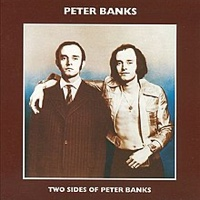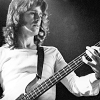Home » Jazz Articles » Album Review » Peter Banks: Two Sides of Peter Banks
Peter Banks: Two Sides of Peter Banks
The album's inconsistency derives from the circumstance that led to its title. The first side of the original 1973 vinyl release is largely a collaboration between Banks and Jan Akkerman, then-guitarist of Dutch progressive rockers Focus, who'd scored a major hit with the album Moving Waves (Sire, 1971) and megahit "Hocus Pocus" which, despite its novelty, brought Akkerman's high octane, fusion-esque playing to an international audience. A series of connected pieces create a side-long suite of composed music that still leaves plenty of room for muscular soloing by both guitarists.
Opening with a stylistic gamut ranging from the ethereal ("Vision of the King") to the jazz-centric ("The White House Vale"), Banks recruits Flash-mates Ray Bennett (bass) and Mike Hough (drums) for the album's first hard-edged track, "Knights." Bennett's too-overt references to Yes' Chris Squire suggest, however, why Flash was doomed to fail. Hough is less directly referential, though the influence of Bill Bruford remains, making Banks' writing and interplay with Akkerman the real stars of the side. With the more distinctive Phil Collins taking over the drum seat for the rest of the album with the fusion-informed "Battles," it only serves to highlight, yet again, Flash's status as a Yes wannabe. He makes the reprise of "Knights"—with King Crimson bassist John Wetton and Genesis guitarist Steve Hackett replacing Bennett and Akkerman on this one track—all the more compelling, even though it lacks the muscular guitar solos of the first go-round, ending in a swinging coda with a hint of Canterbury, before Banks and Akkerman end the side as atmospherically as it began, with "Last Eclipse."
Eclectic it may have been, but if only the second side of the disc were, in retrospect, this good. Following another brief acoustic guitar duo, with Banks layering keyboards and additional guitars, the balance of the side is culled from studio jams that fade in and fizzle out with a distinct shortage of ideas. The 13-minute "Stop That!" has its moments, a modal jam with both guitarists demonstrating their jazzier proclivities, but the closing "Get Out of My Fridge" is nothing more than a heavy-handed opportunity for Banks and Akkerman to trade licks over a plodding country beat.
It's a shame that Banks didn't stick with just one side, but Two Sides of Peter Banks, from the always quality Esoteric, remains worthwhile on the strength of its varied and far more compelling first side.
Track Listing
Vision of the King; The White House Vale: On the Hill, Lord of the Dragon; Knights: The Falcon, The Bear, Battles; Knights (Reprise); Last Eclipse; Beyond the Loneliest Sea; Stop That!; Get Out of My Fridge.
Personnel
Peter Banks
guitarJohn Wetton
bassSteve Hackett
guitarMike Hough
drumsPhil Collins
drumsRay Bennett
guitarJan Akkerman
guitarPeter Banks: electric and acoustic guitars, ARP, Mini-Moog, Fender piano; Jan Akkerman: electric guitar (1, 4, 6, 8, 9), acoustic guitar (7); Ray Bennett; bass guitar (3-5, 8, 9); Phil Collins: drums (4, 5, 8, 9); Steve Hackett: electric guitar (5); Mike Hough: drums (3); John Wetton: bass guitar (5).
Album information
Title: Two Sides of Peter Banks | Year Released: 2010 | Record Label: Esoteric Recordings
< Previous
The Definitive Thad Jones
Next >
Lagos Blues
Comments
Tags
For the Love of Jazz
 All About Jazz has been a pillar of jazz since 1995, championing it as an art form and, more importantly, supporting the musicians who create it. Our enduring commitment has made "AAJ" one of the most culturally important websites of its kind, read by hundreds of thousands of fans, musicians and industry figures every month.
All About Jazz has been a pillar of jazz since 1995, championing it as an art form and, more importantly, supporting the musicians who create it. Our enduring commitment has made "AAJ" one of the most culturally important websites of its kind, read by hundreds of thousands of fans, musicians and industry figures every month.






















